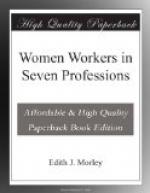At Glasgow the students are all entered at the Women’s College (Queen Margaret’s). The medical course is taken in conjunction with men students. At the Royal Infirmary some wards are open to women for clinical instruction.
At Dublin the students are admitted to the degrees and diplomas in medicine, surgery, and midwifery on the same conditions as men. A special anatomical department with dissecting room, etc., has been erected by the Board of Trinity College for them.
At Edinburgh the arrangements for women students are largely separate from those for the men. The degrees are open to them.
At Durham the degrees are open to women, and most of their work is done with the men.
The same applies to Liverpool, Manchester, Leeds, Birmingham, and Sheffield.
The course takes from five to six years, but it is wise to allow the longer time. The preliminary examination in general subjects is taken before admission to the medical school. After this, the first year at the medical school is spent in scientific study, such as Biology, Inorganic Chemistry, etc. Having passed her first scientific examination, the student proceeds to the study of the human individual, and deals for the next two years with Anatomy, which includes dissection, Physiology, the study of drugs in Materia Medica and Pharmacology, and Organic Chemistry. When the examination in these subjects has been satisfactorily negotiated, she passes on to medical work proper, the study of disease and the result of accident in the living person—in other words, she walks the wards of the hospital and undertakes duties as clerk to physicians and dresser to surgeons, from whom she receives instruction in medicine, surgery, and pathology. Special branches are also studied, such as midwifery, women’s diseases, and affections of the throat, ear, eye, and skin. The treatment of minor accidents also receives special attention. During the whole of this time the student also attends regular courses of lectures on these subjects, and she then takes her final examination. If this be a degree examination, she becomes, on passing it, Bachelor of Medicine, or M.B., and Bachelor of Surgery, Ch.B. or B.S. Having obtained a diploma, she is generally entitled to style herself a Member or Licentiate of the college of which she has passed the qualifying examination, for example, M.R.C.S., L.R.C.P. or L.S.A. On application, she is then placed upon the Medical Register, and is known as a registered medical practitioner.
The cost of the training is approximately as follows :—
For a London Degree.




